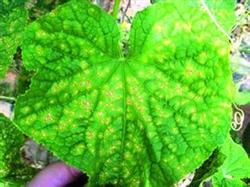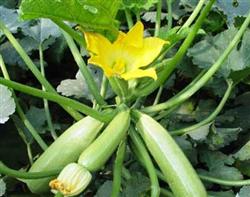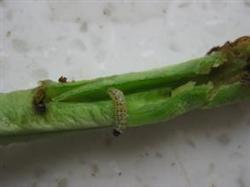Control of Cucumber Target spot

Cucumber target spot is a fungal disease caused by Corynespora cucumeris, so it is also called Corynespora leaf spot. It has been reported in many places in China before, but it is not very serious. In recent years, with the continuous development of protected cultivation, the disease has become an important leaf disease in protected cucumber production, and may cause damage to many vegetables such as tomato. Cucumber target spot mostly occurs after cucumber peak period, first occurs in the middle and lower leaves, forming yellow, round, concave spots on the front of leaves, water stains on the back, commonly known as small yellow spot disease. Gradually expanded into a circular or nearly circular brown spot of varying size. Later, the color of the central spot becomes lighter, and there is an obvious eye-like target in the center of the spot, so it is named target spot disease. Affected by temperature, humidity and cucumber disease resistance, the size, color and mold layer of the disease spots will change greatly, most of which are 8~15 mm in diameter. When humidity is high, light brown mold is produced on the front and back of the disease spots. When the disease is serious, the spots fuse, the leaves are yellow, and the oval grayish brown spots appear on the stems and petioles. Cucumber target spot disease was easily misdiagnosed as downy mildew or bacterial angular spot disease in the field. Identification can pay attention to the following characteristics: downy mildew, bacterial angular spot edge were water-soaked, especially in the morning. The typical target spot has clear boundary; downy mildew and bacterial angular spot are restricted by vein and will be polygonal, while the target spot is slightly round (especially in the early stage of disease); when humidity is high, downy mildew spots grow gray-black mold layer on the back of leaves, which is relatively sparse; bacterial angular spot disease has milky white turbid water drop-like pus on the back of leaves, and white marks after drying. The front and back of target spot disease produce gray-brown mold layer. In addition, leaf spot disease caused by Alternaria or Pseudocercospora may occur on cucumber. Because of similar control techniques, it is not necessary to distinguish strictly. Cucumber target spot disease can be transmitted with seeds, including grafted pumpkin seeds, but more often the pathogen overwinters in soil with conidia, chlamydospores or mycelium, and produces conidia in the next year, which are transmitted by airflow or raindrop splash. The disease is a high temperature and high humidity airborne disease. Large temperature difference between day and night, long dewing time, weak plants, partial application of nitrogen fertilizer plot heavy disease. The following measures should be taken to control target spot disease: soaking cucumber seeds and black-seeded pumpkin seeds for grafting in warm water at 55℃ for 30 minutes; rotating with celery, radish, tobacco, balsam pear or non-melon crops for more than two years, paying attention to thoroughly removing sick and disabled plants in the field and deeply ploughing the soil; avoiding partial application of nitrogen fertilizer, increasing application of phosphorus and potassium fertilizer, and applying appropriate boron fertilizer. After watering, pay attention to ventilation and moisture discharge, remove diseased leaves at the initial stage of disease; chemical control shall be carried out in time at the initial stage of disease. Different from downy mildew and bacterial angular leaf spot, there are many kinds of fungicides to be selected, including broad-spectrum fungicides mancozeb, carbendazim, thiophanate-methyl, chlorothalonil, triazole fungicides propiconazole, difenoconazole, flusilazole, tebuconazole, imidazole fungicides prochloraz, triflumizole, methoxyacrylate fungicides kresoxim-methyl, pyraclostrobin, dicarboximide fungicides iprodione, quinoline copper, amisida, etc. Because bacteria are prone to resistance, it is necessary to reduce the number of doses as much as possible, rotate the use of different types of agents and use compound agents.
- Prev

Grasp the "three tubes" after planting zucchini in spring
The 20-25 days from planting to root melon harvest is the early stage of melon fruiting. The key points of management are heat preservation, water control, mid-tillage, root promotion and seedling protection. After setting the value to 5-7 days before the slow seedling, the herbs should be covered in the morning and evening to keep the greenhouse at 25 ℃ ~ 30 ℃ in the daytime, 15 ℃ ~ 18 ℃ at night, and the ground temperature 20 ℃ ~ 25 ℃. After slowing down the seedlings.
- Next

Planting beans should be high yield and heavy weight to prevent borers
The adults lay eggs on the tender leaves of the plants. After 5~7 days, the hatched larvae eat into the pods and feed on beans. It is difficult to kill the larvae above 3 instars by spraying after they drill into the pods. Therefore, the control of this insect should strengthen the management of fertilizer and water, ensure that the growth is neat, the flowering and pod setting period is relatively concentrated, so as to gather at the critical period.
Related
- Where is it suitable to grow horseradish in China? it is expected to see the middle altitude horseradish in Alishan.
- How to prevent tomato virus disease reasonably? (Control methods included)
- Many people like to plant towel gourd on the balcony. What are the main points of this method and management?
- What crops can chili peppers be mixed with?
- Fertilization techniques and matters needing attention in Tomato
- What are the grafting techniques for peach seedlings in spring?
- Harm and control methods of root swelling disease of Chinese cabbage
- What are the pests of sweet potatoes? How to prevent and cure it?
- Symptoms, causes and Control methods of navel Rot in Tomato
- The cause of "Cucumber rotten bibcock" in Farmers' planting Cucumber and its Control Plan

